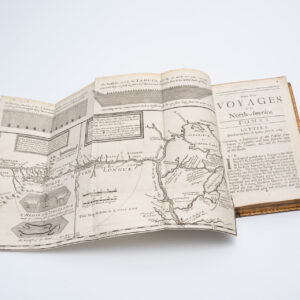In the 17th century, France laid claim to a vast territory in the Americas. In the 1530s Jacques Cartier claimed Canada for France and had explored the Gulf of Saint Lawrence and the Saint Lawrence River. By the 1580s, the French were trading in furs up the Saint Lawrence River, and in 1682, La Salle had explored the Ohio and Mississippi River valleys, laying claim to the vast Louisiana Territory—mostly the Mississippi Valley—for France.
The next year, 1683, Louis Armand, Baron de Lahontan, age 17, arrived in New France as an officer in the French troupe des marines. Over the next 9 years, he traveled extensively, often leading troops in combat against native peoples. He had an inquisitive spirit, which led to his learning Algonquian, and exploring the land in which he lived. In 1687 and 1688, he led troops in the Iroquois Wars, and commanded the Fort St. Joseph (now Port Huron, Michigan) at the southern tip of Lake Huron. In the summer of 1688, knowing that he would receive no supplies to support his command, he burned the fort, and led his men to Michillimackinac—the strait joining Lakes Huron and Michigan—where he hoped to find supplies. During that winter and the following spring, Lahontan explored extensively in the region and to the south in the upper Mississippi valley. Lahontan served until 1692, when, after a conflict with the governor, he deserted service and found passage to Portugal.
Lahontan was an explorer in the sense that he was the first European to travel in certain areas of the North American continent, but his explorations were in lands already claimed by France due to the explorations of La Salle some years earlier. Lahontan’s travels are best known because of his books. In 1703, unable return to France for having deserted service in New France, he was living in Amsterdam, where he published the two volumes of his book New Voyages in North America [Nouveaux Voyages de Mr. Le Baron de Lahontan Dans L’Amerique Septentrionale].
This book was extremely popular and influential in its day—over 20 editions were published from 1703 to the 1740s, including English, Dutch, and German editions, as well as the original French—and is still recognized as perhaps the best seventeenth century book on New France, despite some parts that may be fabrication. It contains extensive descriptions of his exploration of the land, including beaver hunting grounds, portages, French forts, and native and Jesuit settlements. In addition to its descriptions of America, the New Voyages to North America include an extensive political and philosophical dialogue that contains one of major early 18th-century exemplars of the “noble savage,” in the character of one Adario [i.e., “the Rat,” based on the real Huron chief Kondiaronk], a supposed Huron chief, who debates with the character Lahontan on a range of religious, philosophical, and political issues in the course of the four dialogues included in the second volume.
One of his most notable discoveries was La Rivière Longue, which was possibly the Missouri River valley, or was possibly no more than a fiction. As described in more detail below, this idea would have an enormous and lasting impact on the European cartographic representations of North America for nearly a century to follow.
-
-
Add to cartQuick View
- Americas, Atlases & Books, Canada and The Great Lakes, North America
New Voyages to North-America. Containing an Account of the Several Nations of That Vast Continent…
- $8,500
- First English edition of Lahontan's description and mapping of New France, which propagated the myth of the Northwest Passage.
-
Add to cart
Archived
- Out of Stock
- Atlases & Books, Canada and The Great Lakes
Nouveaux Voyages de Mr. Le Baron de Lahontan Dans L’Amerique Septentrionale, Qui contiennent une relation…
- Rare first edition of Lahontan's description and mapping of New France, which propagated the myth of the Northwest Passage.
- Read moreQuick View
-


